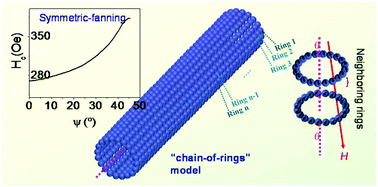The magnetization reversal mechanism in electrospun tubular nickel ferrite: a chain-of-rings model for symmetric fanning†
Abstract
Magnetic behaviors within nanoscopic materials are being widely explored due to their intriguing performance and widespread applications. Herein, we studied the magnetization reversal mechanism in a unique tubular nickel ferrite (NiFe2O4), in which the building blocks of NiFe2O4 monocrystalline have a face-centered spinel structure and stack along the axial direction of the nanotube. We synthesized this tubular NiFe2O4 through an electrospinning method based on a phase separation process, and then investigated the magnetization reversal process and its relationship with the morphologies using the model of “chain-of-rings” from the micromagnetism theory. This model is developed based on the morphology and crystalline orientation of nanotubes, by which the symmetric fanning mechanism is demonstrated when the angle between the magnetic field and the chain is less than 45.3°. As a result, the simulated coercivity value is confirmed to be 271 Oe, which is close to the experimental value. In addition, the rationality of this model was further verified by the calculation of the effective magnetic anisotropy field. This work is significant for the application of tubular ferrite in the field of nano-devices and fundamental research.



 Please wait while we load your content...
Please wait while we load your content...